The failure of the last major offensive of the Wehrmacht
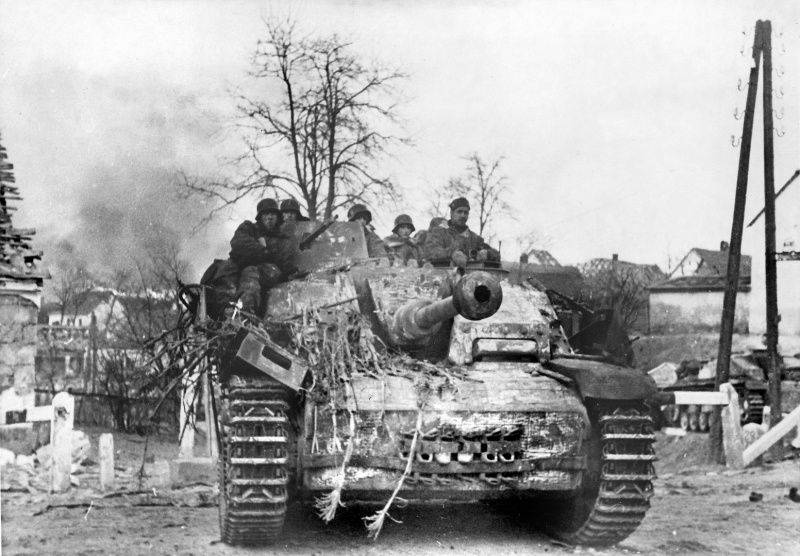
70 years ago, 6 March 1945, the Balaton operation began. It was the last major defensive operation of the Red Army against the German troops during the Great Patriotic War. Soviet troops repelled the attack of the German Army Group South (Operation Spring Awakening) and launched an offensive against Vienna.
The German command hoped to push the Red Army beyond the Danube, thereby eliminating the threat to Vienna and the southern regions of Germany and retaining one of the last oil fields available to the Germans. German offensive 6th tank SS Army, 2nd Tank and 6th Field, 3rd Hungarian Army was the last major offensive operation of the Wehrmacht in World War II.
The position before the operation. Party plans
Soviet Union. The offensive of the Soviet troops on the southern wing of the strategic Soviet-German front led to the liberation from Nazism and the pro-fascist forces of Southeast and Central Europe. The active offensive of the 2, 3 and 4 of the Ukrainian fronts in Hungary and Czechoslovakia was delayed by large forces of the German troops from the central, Berlin direction. Soviet troops were approaching the borders of southern Germany. The defeat of the Third Reich was just around the corner.
Three days after the capture of Budapest, February 17, the Supreme Commander ordered the troops of the 2 and 3 of the Ukrainian fronts to conduct an offensive operation in order to defeat Army Group South and capture the region of Bratislava, Brno and Vienna. Soviet troops had to go to the approaches to southern Germany. The troops of the 2 of the Ukrainian Front were to strike from the region north of Esztergom in the direction of Bratislava and then on Vienna. The 3 Ukrainian Front planned a strike from the area north of Lake Balaton, bypassing the capital of Austria from the south. The offensive was scheduled for March 15.
By mid-February, the main forces of Malinovsky fought in the south-eastern part of Czechoslovakia and liberated part of Slovakia. February 17, the enemy's strike force, which numbered 400 tanks and SPGs (1 tank corps of the SS), struck 7 Guards Army Shumilova, which occupied a bridgehead on the west bank of the River Gron. During the brutal battle, the army of Shumilov suffered heavy losses and was forced to leave the bridgehead, moving to the east bank of the river. Malinovsky threw a number of reinforcements into the battle area and stabilized the front. The Germans could not develop the first success.
The troops of the 2 of the Ukrainian Front were located north of the Danube, at the turn of the river Hron. The troops of the 3 of the Ukrainian Front and the 46 of the 2 of the Ukrainian Front fought in the western part of Hungary at the turn east of Esztergom, the southwestern shore of Lake Velence, Lake Balaton and the northern shore of the Drava. On the left flank of the front Tolbukhina troops of the People’s Liberation Army of Yugoslavia acted.
However, even before the completion of the preparation of a new offensive, in the second half of February, Soviet intelligence obtained data on the concentration of a powerful German tank group in Western Hungary. Initially, these data were perceived in the General Staff with suspicion. It was surprising that at that moment, when the Soviet troops were in 60 km from Berlin and were preparing to attack the German capital, Hitler removed the 6 th SS tank amy from the west and transferred it not to Berlin, but to Hungary.
Soon the data was confirmed, and it became clear that the enemy was preparing a major offensive in the area of Lake Balaton. Therefore, the Soviet Stake gave instructions to 2 and 3 in the Ukrainian fronts to go on the defensive, deplete the enemy in tough defensive battles and defeat the German shock group. At the same time, the Soviet troops were to continue the preparation of the Vienna operation, so that immediately after the defeat of the enemy grouping they went on the offensive in the Vienna direction.
Intelligence data on the rearrangement of enemy forces made it possible to identify the directions of impending strikes and, most importantly, the direction of the main attack. The command of 3 of the Ukrainian Front, using the experience of the Battle of Kursk, in the intended direction of the main attack of the enemy equipped a defense in depth. In some places its depth reached 25-30 km. Special attention was paid to anti-tank defense, including the creation of barriers of all kinds. Dangerous directions were heavily mined. In total, 83-kilometer stretch from Lake Balaton to Gant, where the main attack of the enemy’s armored forces was awaited, prepared 66 anti-tank areas and concentrated almost two thirds of the entire front artillery. At a number of sites, the density of guns and mortars brought the 60-70 trunks to one kilometer. Shelters for people and equipment were prepared, anti-tank reserves were allocated. Particular attention was paid to the possibility of a wide maneuver by forces both on the front and from the depths.
In the area where the main attack of the enemy was awaited, Soviet troops were deployed in two echelons. The first was the 4-I Guards Army of Nikanor Zakhvatayev and the 26-I Army of Nikolai Gagen, the second - the 27-I Army of Sergei Trofimenko, which was transferred from the 2-Ukrainian Front. On the secondary direction from the western tip of Lake Balaton were the troops of the 57-th army of Mikhail Sharokhin. On the left flank, the 1 th Bulgarian army was under the command of Vladimir Stoychev. The left flank of the 3 of the Ukrainian Front in the Valpovo area was adjacent to the 3-I Yugoslav Army. The 18 th and 23 th tank, 1 th Guards mechanized and 5 th Guards cavalry corps, as well as several artillery and other units and formations were located in the reserve of the front.
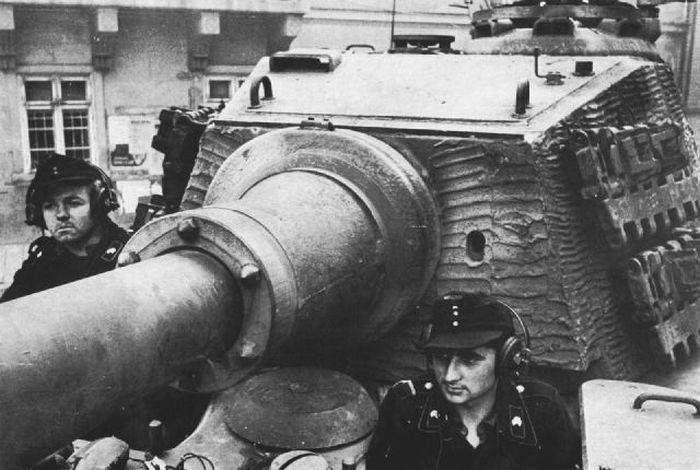
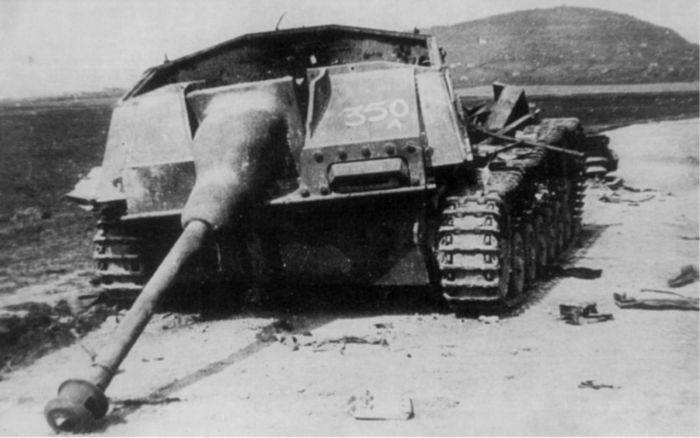
Germany. By order of Adolf Hitler, the German-Hungarian troops were to launch a counteroffensive in the area of Lake Balaton. As early as mid-January 1945, the High Command issued an order to transfer the 6-th SS Panzer Army from the Ardennes and a number of formations from Italy to Hungary. 25 January 1945 The Fuhrer declared that the oil-bearing areas and oil sources of Hungary are of paramount importance now, since without this area, which gives the Third Reich 80% oil production, it will be impossible to continue the war. Germany has only two oil fields left - in Zietersdorf (Austria) and in the area of Lake Balaton (Hungary). In order to keep the last sources of oil necessary for the air and armored forces, the German High Command transferred the main strike forces from the Western Front to Hungary.
Despite the threat in the Berlin area and the heavy fighting in Eastern Pomerania, where they initially wanted to transfer the SS 6 tank army, the German command decided to launch a counterstrike in Hungary. With the success of the operation, the Germans hoped to throw the Red Army troops beyond the Danube, eliminating the threat of southern Germany to their groups in Austria and Czechoslovakia.
Thus, the German command continued to attach exceptional importance to the holding of the Hungarian bridgehead, from where the routes to Austria and southern Germany went. In Western Hungary and Austria, there were the last oil production areas and refineries, whose products were of key importance to the tank and air forces. And Austria was important for the presence of large steel, engineering, automotive and armory factories, industry for the production of ammunition. So by the beginning of 1945, 600 Austrian enterprises were producing a significant amount of weapons, equipment and ammunition every month. Western Hungary and Austria were the last lines of defense from the south. In addition, these areas provided human resources to continue the war.
The German command has developed a plan of operation "Spring awakening." Wehrmacht struck three dissecting strike. The 6-I SS tank army of Joseph (Zapp) Dietrich and the 6-I field army of George Balck attacked the main attack from the area of Velence and the north-eastern part of Lake Balaton. They were supported by the 3-I of the Hungarian army of Josef Hezenia. The main strike force of Army Group South was striking in a southeast direction against Dunafüldvár. In some areas, 50-70 tanks and assault guns were concentrated on 1 km of front.
The second blow south of. Balaton, from the Nagykanikis region, in the direction of Kaposvar, applied the 2-I tank army of Maximilian de Angelis. The German forces delivered the third blow from the Donji-Miholyats area to the north, on Pecs and on the Mokhach direction towards the 6 SS Panzer Army. It was applied by the 91 Army Corps from Army Group E.
Three dissecting blows were to destroy the Soviet defense, to destroy the front of the 3 of the Ukrainian Front. After the German troops reached the Danube, they were to develop an offensive to the north with a part of the forces and fight off Budapest, and with a part of the forces to turn south. The beginning of the attack was scheduled for the morning of March 6 1945.
Thus, the German troops received the task of destroying in parts the main forces of the 3 of the Ukrainian Front and dropping the remnants of the Soviet troops beyond the Danube. This made it possible to restore the front line along the Danube, and to stabilize the situation on the entire strategic southern sector of the Eastern Front. After the successful completion of the Balaton operation, it was possible to strike the flank with a blow to the 2-th Ukrainian Front. After this, the liberated forces, primarily armored formations, were planning to transfer to Berlin, strengthening its defenses.
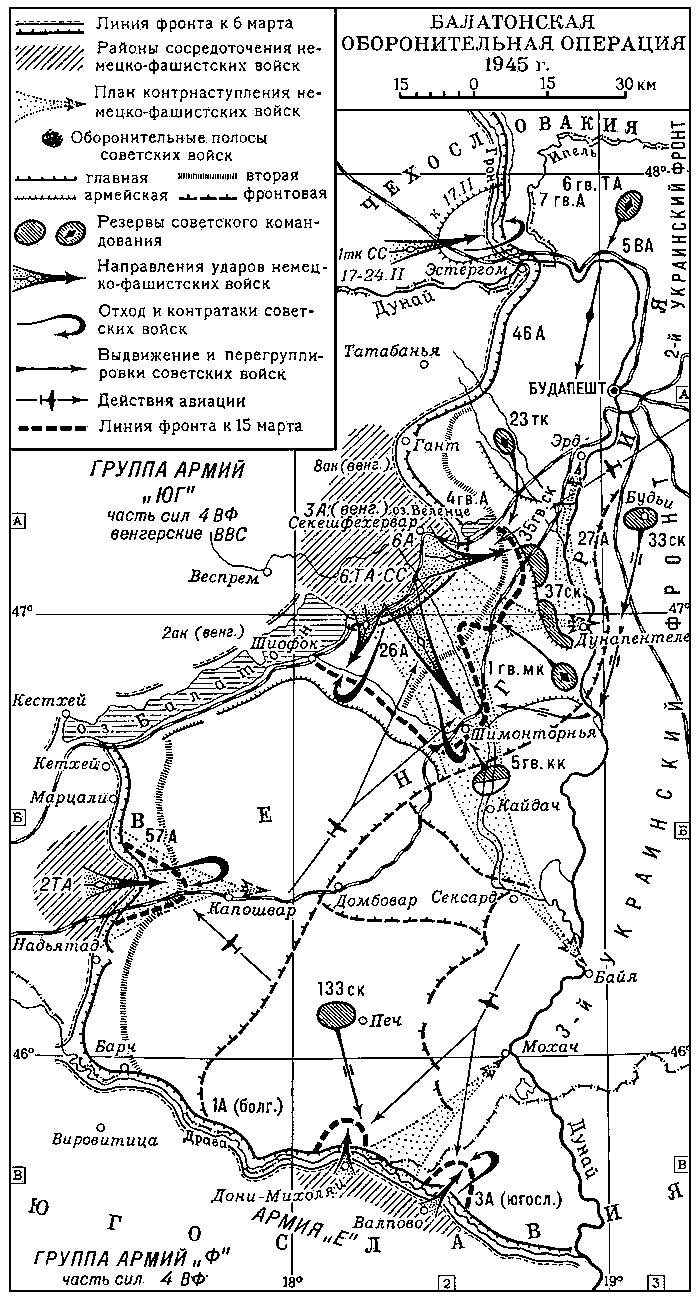
The forces of the parties
THE USSR. The 3 of the Ukrainian Front under the command of Fyodor Tolbukhin included Soviet 37 rifle divisions, 3 cavalry divisions and 6 Bulgarian infantry divisions, 1 fortified area, 2 tank and 1 mechanized corps. From the air, ground troops supported the forces of the 17-I air army of Vladimir Sudetz and the 5-I air army of Sergey Goryunov from the 2-second Ukrainian front. There are more than 400 thousands of soldiers and officers, about 7 thousand guns and mortars, 400 tanks and self-propelled guns, about 1 thousand planes.
Germany. The forces of the 3rd Ukrainian Front were opposed by the forces of Army Group “South” under the command of Otto Wöhler: the 6th SS Panzer Army, the “Balk” Army Group (6th Army, the remnants of the 1st and 3rd Hungarian armies), 2- I am a tank army; and part of Army Group E. From the air, German-Hungarian troops supported part of the 4th air fleet and the Hungarian air force.
Together with the 6 SS Panzer Army deployed from the Western Front, the German forces numbered 31 divisions, including 11 tank, 5 combat groups and 1 motorized brigade. There are more than 430 thousand soldiers and officers, more than 5,6 thousand guns and mortars, about 900 tanks and SPGs, 900 armored personnel carriers and 850 combat aircraft.
Thus, by the number of infantry Germans and Hungarians had a slight advantage, in artillery and airplanes there was a slight advantage over the Red Army. But in terms of tanks and self-propelled guns, the Germans had more than double superiority and placed their main hope on them.
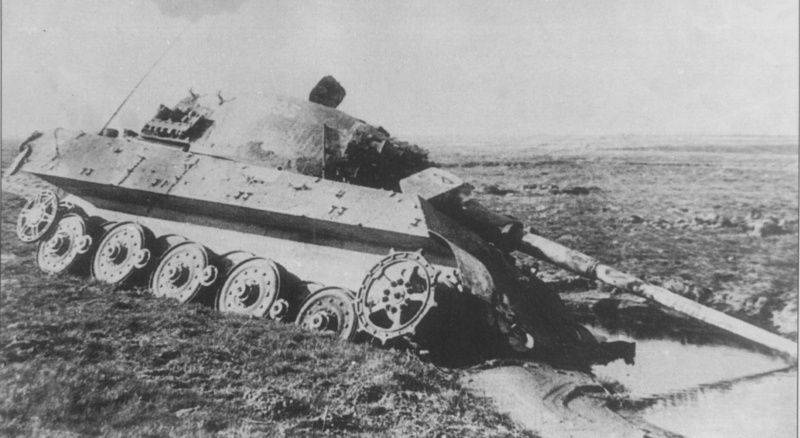
The Royal Tiger heavy tank from the Feldkhernhalle heavy tank battalion hit a mine and dropped into a ditch
Photo source: http://waralbum.ru/
Battle
German troops delivered a powerful blow to 6 March 1945. The first blows were delivered on the southern flank. Even at night, positions of the Bulgarian and Yugoslav armies were attacked, and early in the morning they hit the 57 army. At the site of the 57 Army, the Germans carried out an hour-long artillery preparation and at the cost of great efforts and losses could penetrate the Soviet defense. However, the command of the army undertook a series of retaliatory measures, introducing second-echelon troops and artillery reserves into the battle, which prevented further advance of the enemy. As a result, the Germans advanced just 6-8 km south of Lake Balaton.
The Germans, in spite of the brave resistance of the Bulgarian and Yugoslav forces, crossed the Drava and captured two bridgeheads, each with a width of up to 1 km in depth, in the area of the 3 th defense of the Bulgarian and 8 th Yugoslav armies. However, the German troops failed to launch an offensive against Pec and Mohacs. The Soviet command, in order to strengthen the defense in this sector, sent the 5 Infantry Corps and the division of the Guard mortars to help. This stabilized the situation in this sector of the front. The Bulgarian and Soviet troops, with the support of the Soviet forces, repulsed the blow of the troops of Army Group “E” and launched a counterattack. German beachheads were eliminated. Fighting on this frontline continued until March 133. Thus, the German offensive on the southern flank (Operation “Forest Devil”) was foiled.
In the morning, after the 30-minute artillery preparation, the German 6-I tank army SS and 6-I field army launched an offensive in the sector of the 4-th guards and 26-th armies. To break through the Soviet defense, the Germans massively threw armored vehicles into battle. In some areas, the number of tanks and assault guns reached 70 vehicles on 1-2 km of front. Massively used new heavy and medium tanks "Tiger-2" and "Panther". By the end of the day, the Germans had penetrated 4 km into the defenses of the Soviet troops and took the Sheregayes stronghold. The Soviet command, in order to strengthen the defense, began to introduce the 18 tank corps into battle. The 3 amphibious division of the 35 Guards Rifle Corps from the 27 Army was also sent here. On the same day, stubborn battles were fought in the defense zone of the 1 Guards Fortified Area of the 4 Guards Army.
March 7, with the massive support of the Luftwaffe, the German troops resumed the offensive. A particularly difficult situation was in the defense zone of the 26 Army of Gagen, where it was concentrated to 200 tanks and SPG. The Germans constantly maneuvered their forces, looking for weak points in the defense of the Soviet army. The Soviet command transferred anti-tank reserves to the threatened sectors. Army Gagen reinforced 5-m Guards Cavalry Corps and 208-th self-propelled artillery brigade. In addition, in order to strengthen the defense of the first echelon, Trofimenko, the 27 Army, began to move into the second line of defense. A large role in repelling the enemy offensive that day was played by massive strikes of Sudetz's 17 Air Army in the attacking orders of the German tank and infantry divisions.
In two days of persistent battle, the German forces were able to penetrate into the Soviet defense four kilometers south of the island of Velence and seven kilometers west of the Sharviz Canal. The Wehrmacht could not break through the tactical zone of defense of the Soviet troops. Timely measures taken to strengthen the defense and stubborn resistance of the Soviet troops prevented the Germans from breaking through.
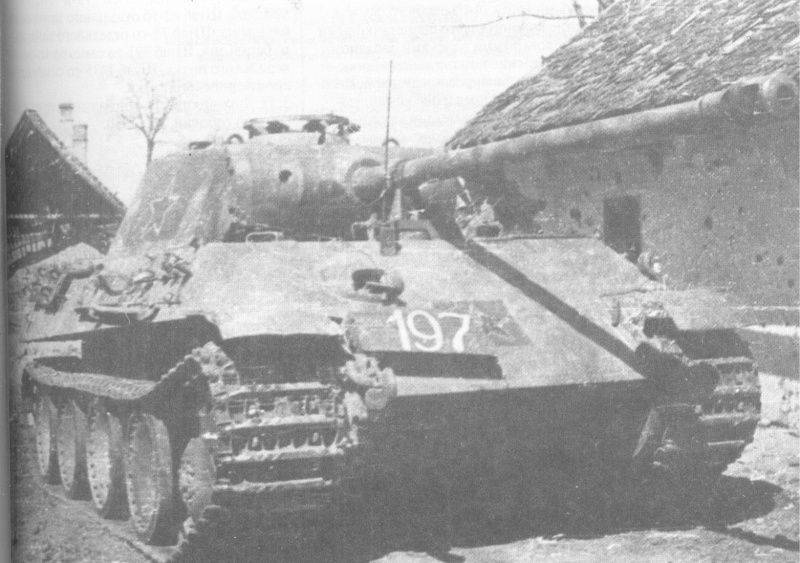
Trophy German tank Pz.Kpfw. V "Panther" from the 366 th SAP (self-propelled artillery regiment). 3-th Ukrainian Front. Hungary, March 1945 of the year
On March 8-9, heavy fighting continued. On March 8, the German command brought its main forces into battle. The Germans continued to look for weaknesses, throwing large masses of armored vehicles into attacks in some areas. More than 250 tanks and self-propelled guns operated in the direction of the main attack. The fighting continued day and night. Based on a decrease in the effectiveness of the Soviet aviation and artillery the Germans continued their attacks even at night. On March 9, the German command brought another tank division into battle. As a result, the Hagen army held back the onslaught of up to 320 tanks and self-propelled guns.
As a result, the Wehrmacht broke through the main and second lines of defense of the Soviet troops and penetrated 10-24 kilometers in the main direction. However, success was still far away, since it was necessary to break through the rear army and front lines of defense, and the main forces were already brought into battle and suffered heavy losses. From 10 in March, at the direction of the Stavka, the aviation of the 2 of the Ukrainian Front — the 5-I Air Army of Goryunov — joined the enemy offensive. In addition, by order of the Stavka, the 3 th Guards Army of the Glagolev deployed to the south-east of the Hungarian capital was transferred to the 9 of the Ukrainian Front. Tolbukhin had a large reserve in case the situation worsened.
Especially hard fighting broke out on March 10-14. On March 10, an enemy armored fist between Velenze and Balaton had already 450 machines. There were fierce battles. A huge role in repelling enemy attacks in these days was played by artillery, aircraft and tanks. The German command, trying to break into the Soviet defenses at all costs, March 14 threw into its battle its last reserve - the 6 Tank Division. For two days only the troops of the 27 Army Trofimenko opposed the powerful enemy grouping with more than 300 tanks and assault guns. The Germans were able to advance 30 km into the depths of the Soviet defense.
However, soon the forces of the German divisions were exhausted. There were no reserves to continue the offensive. The Germans could not completely break through the defenses of the Soviet armies. By the end of March 15, many German units, including selected SS units, having lost faith in the success of the further offensive, began to refuse to go on the attack. As a result, the German counteroffensive choked. Under the cover of tank units, which continued to fight hard, the rest of the troops began to retreat to their original positions and went over to defense. Hitler went into a rage and ordered the SS 6 tank army to dismantle the honorary armbands from the uniform.
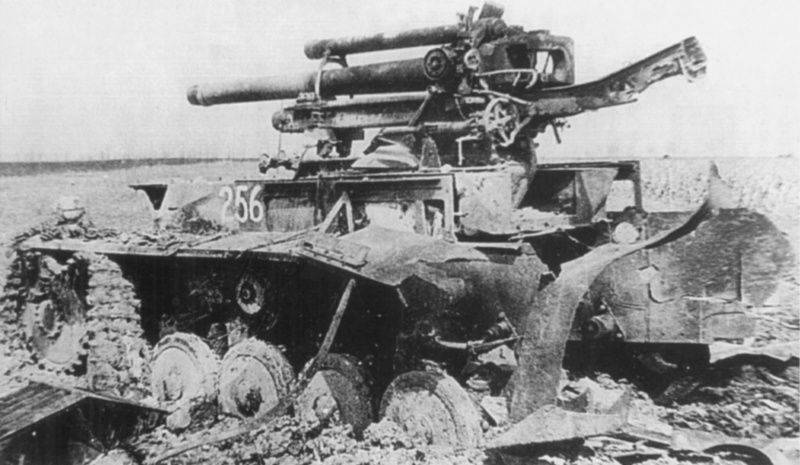
German SAU "Vespe" after hitting a large-caliber projectile. Hungary, Lake Velence
Results
The last major German offensive ended with the defeat of the Wehrmacht. A major role in this success of the 3 of the Ukrainian Front was played by intelligence, which in time revealed the plans of the enemy. Otherwise, the situation could be much more dangerous.
German troops suffered heavy losses in personnel and equipment - more than 40 thousand people, about 500 tanks and self-propelled guns, more than 300 guns and mortars, about 200 aircraft. But the most important thing was finally undermined the morale of the Wehrmacht, including selected SS troops. The positions of the German-Hungarian troops in Western Hungary were weakened, which played a large role in the subsequent Vienna offensive. In addition, the weakened 6-SS Panzer Army, which lost most of its equipment, could not help the defense of Berlin.
Soviet troops were able to exhaust the enemy with stubborn defense, disrupting the Germans' attempt to restore the front along the Danube, and almost without operational pause went over to the offensive in the Vienna direction. The loss of the 3 of the Ukrainian Front amounted to about 33 thousand people. The Bulgarian-Yugoslav troops were able to repel the blows of the enemy and, by going to the counter-offensive, captured the cities of Drava Sabolch, Drava Polkonya and several other settlements.
Brief in time, but saturated with events and persistent battles, the Balaton operation along with the battle of Kursk is a model of the high organization and skillful conduct of operational defense by the Red Army.
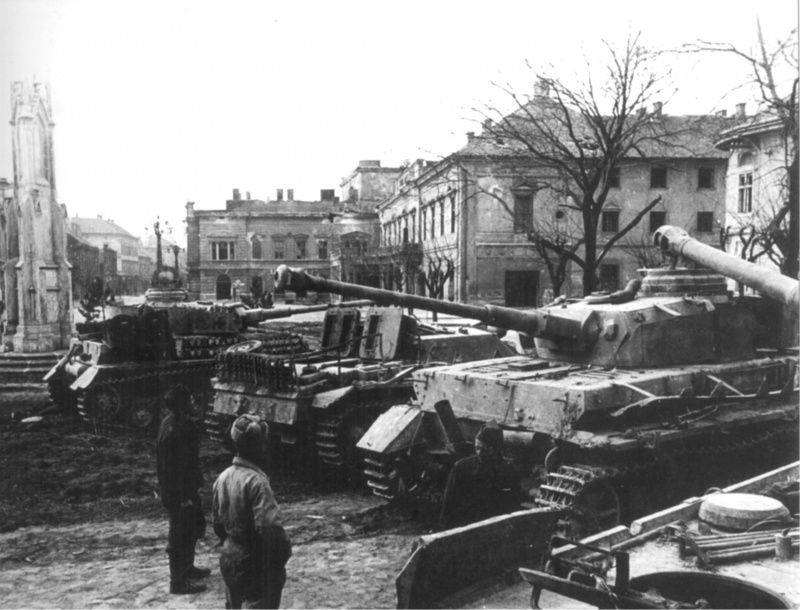
Captured by Soviet troops in the city of Szekesfehervarvar, German tanks and self-propelled guns, abandoned due to lack of fuel
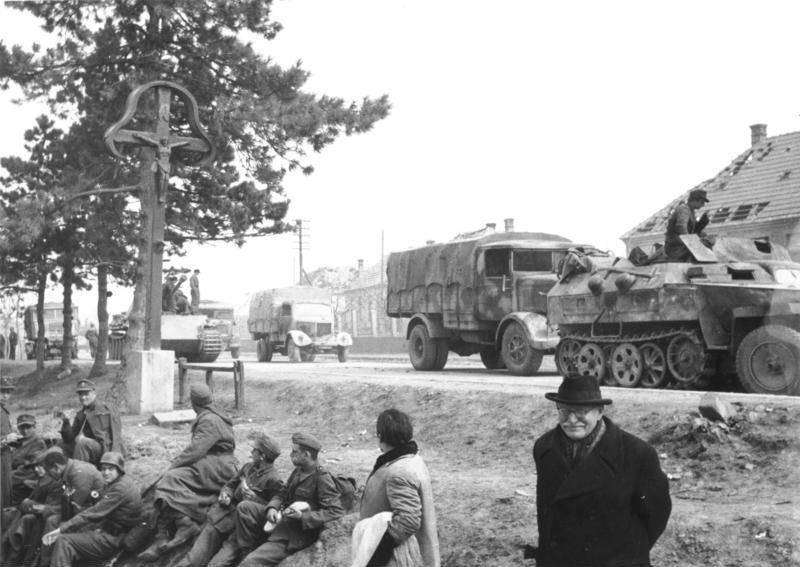
Germans retreat from Hungary
Information